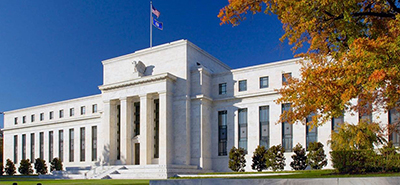
Fed Approves 1st Rate Hike in 4 Years

The Federal Open Market Committee on Wednesday raised the federal funds rate for the first time since 2018, marking a new approach to rising inflation and other economic pressures.
The FOMC raised the federal funds rate by 25 basis points to 0.25-0.50 percent, marking the first time the FOMC has changed the federal funds rate since March 2020, when it lowered the rate to 0.00-0.25 percent; and the first time it has raised rates since 2018.
“The invasion of Ukraine by Russia is causing tremendous human and economic hardship,” the Fed said in its policy statement. “The implications for the U.S. economy are highly uncertain, but in the near term the invasion and related events are likely to create additional upward pressure on inflation and weigh on economic activity.”
Nor will this likely be the last increase; in its statement, the FOMC said it “anticipates that ongoing increases in the target range will be appropriate.”
Mike Fratantoni, Chief Economist with the Mortgage Bankers Association, said the 25 basis point increase was widely anticipated and carefully telegraphed so that markets could prepare accordingly.
“More importantly, it clearly signaled that additional hikes are coming, with the median FOMC member expecting to raise rates at each of the remaining six meetings in 2022,” Fratantoni said. “With the unemployment rate below 4%, inflation nearing 8% and the war in Ukraine likely to put even more upward pressure on prices, this is what the Fed needs to do to bring inflation under control. The FOMC economic projections indicate slower growth and higher inflation than had been the expectation at their December meeting. Note that they do not expect to be back at 2% inflation until after 2024.”
Beyond the hike in short-term rates, Fratantoni said the Fed also indicated it plans to begin to shrink its balance sheet, with Treasuries and mortgage-backed securities being allowed to passively roll off. “Although we anticipate that shrinking the balance sheet will begin this summer, we will be looking for details regarding the pace of the runoff and whether they would consider active MBS sales at some point to return to an all-Treasury portfolio,” he said.
MBA forecasts mortgage rates will rise further over the next year to around 4.5%. “Mortgage rates have been exceptionally volatile in recent weeks, given the profound uncertainties both with respect to the geopolitical situation and monetary policy,” Fratantoni said. “Hopefully, the Fed’s actions and explanations can help to reduce the policy uncertainty, which would then diminish some of the current volatility.”
“The Federal Reserve faces a unique challenge in the year ahead – tame inflation without throwing the economy into a recession,” said Odeta Kushi, Deputy Chief Economist with First American Financial Corp., Santa Ana, Calif. The dot plot released along with FOMC minutes on Wednesday may signal how much the Fed’s expectations around inflation, GDP and rate hikes have shifted since December. “
Kushi said rising interest rates will have an effect on housing. “House price growth continues to remain near record highs, and a severe supply-demand imbalance in the housing market indicates that house prices will continue to grow for the foreseeable future,” she said. “However, as rates do rise, affordability may become an issue for some buyers on the margin. As buyers pull back from the market and sellers adjust their price expectations, house prices will likely moderate”
Kushi added one possible outcome from rising rates could be “a market that moves closer to equilibrium, with less price appreciation than last year.”
The full FOMC statement follows:
“Indicators of economic activity and employment have continued to strengthen. Job gains have been strong in recent months, and the unemployment rate has declined substantially. Inflation remains elevated, reflecting supply and demand imbalances related to the pandemic, higher energy prices, and broader price pressures.
“The invasion of Ukraine by Russia is causing tremendous human and economic hardship. The implications for the U.S. economy are highly uncertain, but in the near term the invasion and related events are likely to create additional upward pressure on inflation and weigh on economic activity.
“The Committee seeks to achieve maximum employment and inflation at the rate of 2 percent over the longer run. With appropriate firming in the stance of monetary policy, the Committee expects inflation to return to its 2 percent objective and the labor market to remain strong. In support of these goals, the Committee decided to raise the target range for the federal funds rate to 1/4 to 1/2 percent and anticipates that ongoing increases in the target range will be appropriate. In addition, the Committee expects to begin reducing its holdings of Treasury securities and agency debt and agency mortgage-backed securities at a coming meeting.
“In assessing the appropriate stance of monetary policy, the Committee will continue to monitor the implications of incoming information for the economic outlook. The Committee would be prepared to adjust the stance of monetary policy as appropriate if risks emerge that could impede the attainment of the Committee’s goals. The Committee’s assessments will take into account a wide range of information, including readings on public health, labor market conditions, inflation pressures and inflation expectations, and financial and international developments.
“Voting for the monetary policy action were Jerome H. Powell, Chair; John C. Williams, Vice Chair; Michelle W. Bowman; Lael Brainard; Esther L. George; Patrick Harker; Loretta J. Mester; and Christopher J. Waller. Voting against this action was James Bullard, who preferred at this meeting to raise the target range for the federal funds rate by 0.5 percentage point to 1/2 to 3/4 percent. Patrick Harker voted as an alternate member at this meeting.”
